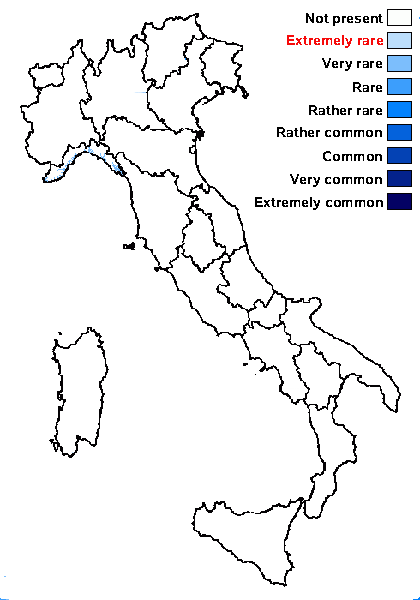Involucropyrenium sbarbaronis (Servít) Breuss
Stapfia, 23: 134, 1990. Basionym: Dermatocarpon sbarbaronis Servít - Ann. Mus. Civ. St. Nat. Genova, 64: 55, 1950.
Synonyms: Catapyrenium sbarbaronis (Servít) Breuss
Distribution: N - Lig.
Description: Thallus squamulose to subcrustose, beige to pale brown, epruinose, thin, sometimes delimited by a pale prothallus. Squamules 0.4-1 mm broad, rounded to crenate, flattened to slightly convex, smooth, contiguous, mostly forming a subcrustose thallus. Lower surface attached by c. 4 µm thick, pale rhizohyphae. Upper cortex paraplectenchymatous, of small isodiametrical cells, rather thin, poorly differentiated from the algal layer; lower cortex absent. Perithecia black, 0.3-0.35 mm wide, developing from the hypothallus and located among the squamules, at first globose, then pyriform, projecting, with an involucrellum extending all around the perithecium. Exciple dark throughout; hamathecium of periphyses, interascal filaments absent. Asci 8-spored, narrowly clavate, with biseriately arranged spores, the wall I-, 70-80 x 17-20 µm. Ascospores 1-celled, hyaline, narrowly ellipsoid, thin-walled, 15-20(-22) x 6-8 µm. Pycnidia unknown. Photobiont chlorococcoid. Spot tests: cortex and medulla K-, C-, KC-, P-, UV-. Chemistry: without lichen substances.Note: only known from the type collection, this terricolous species deserves further study. Indicator values are tentative.
Growth form: Squamulose
Substrata: soil, terricolous mosses, and plant debris
Photobiont: green algae other than Trentepohlia
Reproductive strategy: mainly sexual
Poorly known taxon in need of further study
Commonnes-rarity: (info)
Alpine belt: absent
Subalpine belt: absent
Oromediterranean belt: absent
Montane belt: absent
Submediterranean belt: absent
Padanian area: absent
Humid submediterranean belt: absent
Humid mediterranean belt: very rare
Dry mediterranean belt: absent

Predictive model
Growth form: Squamulose
Substrata: soil, terricolous mosses, and plant debris
Photobiont: green algae other than Trentepohlia
Reproductive strategy: mainly sexual
Poorly known taxon in need of further study
Commonnes-rarity: (info)
Alpine belt: absent
Subalpine belt: absent
Oromediterranean belt: absent
Montane belt: absent
Submediterranean belt: absent
Padanian area: absent
Humid submediterranean belt: absent
Humid mediterranean belt: very rare
Dry mediterranean belt: absent

Predictive model
 INDEX FUNGORUM
INDEX FUNGORUM
 GBIF
GBIF



